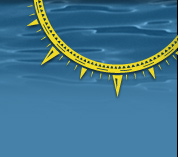
 |

|
 RiverQuestion of the MonthAugust 2009Compiled by Jennifer Robertson, M.Ed.RiverQuest Education SpecialistQuestion:What are the origins of the terms referring Answers:Bow, meaning the “front of a ship,” can be traced to the time of the Vikings. The root word literally translates as “shoulder.” The idea is that the bow is the “shoulders of the ship.” Stern, meaning the “hind part of a ship” or “steering gear of a ship” came into use around 1300 A.D. The term may come from a northern European root word related to the term “steer.” The term starboard originates from the Old English “steorbord” which literally means the “side on which a vessel was steered.” It is related to the terms rudder and steering paddle. The left side of a ship was first referred to as the port side in the 1500s. Prior to the 16th century, the left side of a ship was called the larboard side. Larboard was derived from a term that referred to the loading side of a ship. When giving directions at sea, the words larboard and starboard could be easily confused, prompting sailors to begin using the term port in place of larboard. The U.S. Navy officially adopted the word port, in reference to the left side of a ship, in 1846. Helm, meaning the “steering apparatus of a ship,” derives from an Old English term referring to the “position of guidance, control.” A ship’s toilet was first referred to as the head in the first half of the 18th century. The toilet was typically located on the bow of the ship, which was also referred to as the head of the ship. The term was widely circulated in a privateer’s account of his expedition at sea and in an unrelated novel.
Comment? Question?Email your feedback to us at info@riverquest.org. Thanks!
Sources:
<< Back to RiverQuest Homepage
|